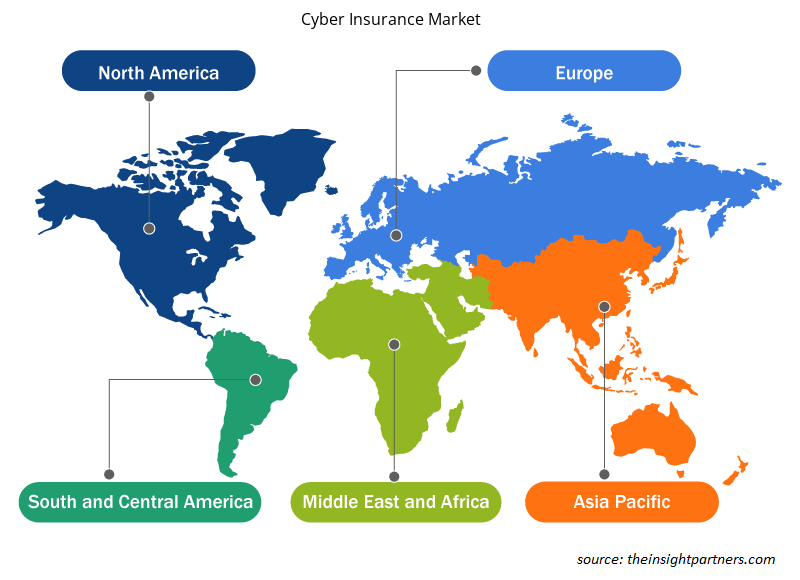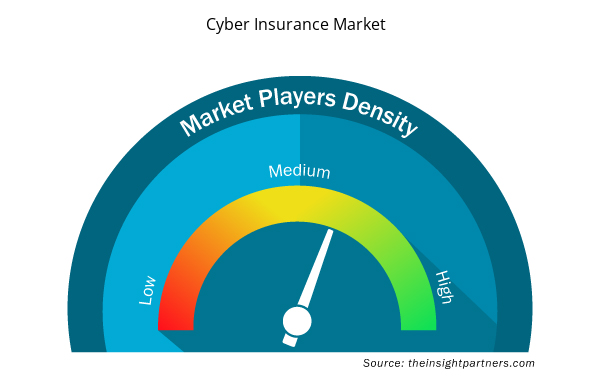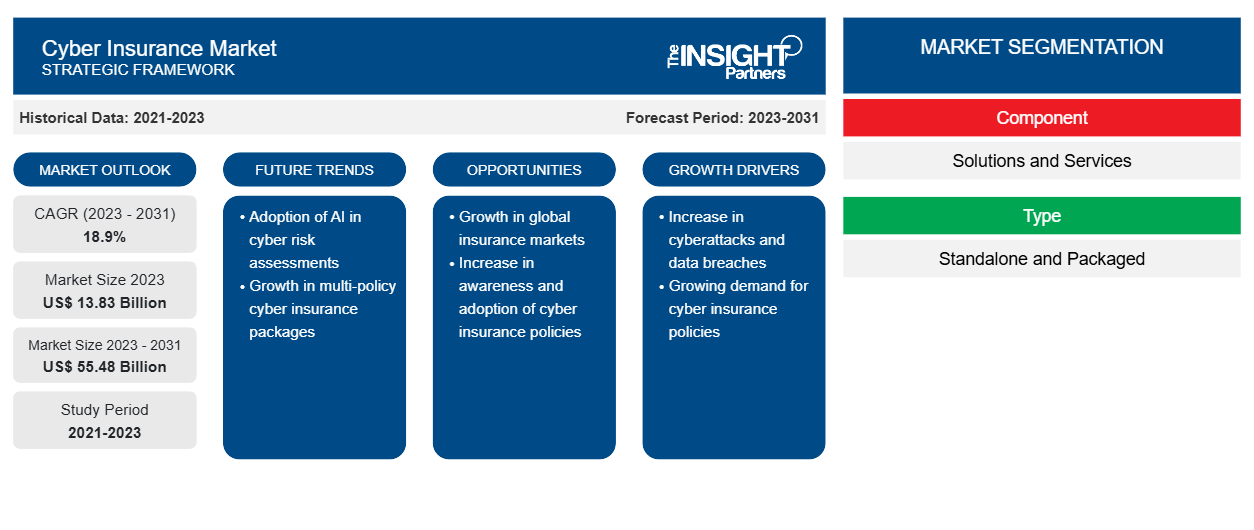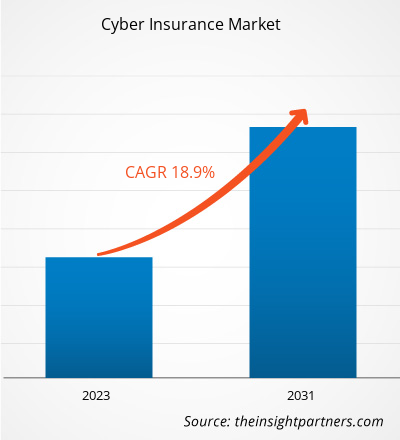サイバー保険の市場規模は、2023 年の 138.3 億米ドルから 2031 年には 554.8 億米ドルに拡大すると予想されており、2023 年から 2031 年にかけて 18.9% の CAGR で拡大すると予想されています。サイバー保険は、サイバー賠償責任保険またはサイバーセキュリティ保険とも呼ばれ、組織がオンラインでのビジネスに伴う財務リスクを軽減するために購入できる契約です。毎月または四半期ごとの料金と引き換えに、保険契約によりリスクの一部が保険会社に移転されます。
サイバー保険市場分析
サイバー保険市場の予測は、主要な企業出版物、協会データ、データベースなど、さまざまな二次および一次調査結果に基づいて推定されています。アプリケーション、デバイス、ネットワーク、ユーザーに対するサイバー攻撃の脅威が増大するにつれて、サイバー保険はすべての企業にとってますます重要になっています。これは、データの侵害、損失、盗難が、顧客の損失から評判や経済的損害に至るまで、ビジネスに重大な影響を及ぼす可能性があるためです。企業は、サードパーティのデータの損失または盗難によって引き起こされた損害に対して責任を問われることもあります。サイバー保険契約は、サイバーテロなどのサイバーイベントから組織を保護し、セキュリティインシデントの解決を支援することができます。たとえば、ASTRA IT、Inc.の2024年のレポートによると、サイバーセキュリティの統計によると、毎日2,200件のサイバー攻撃があり、平均39秒ごとに1件発生しています。米国では、データ侵害の平均コストは944万ドルで、サイバー犯罪のコストは2023年に最大8兆ドルに達します。
サイバー保険
業界概要
- サイバー攻撃と侵害されたデジタル資産の数は同時に増加しています。過去数年間、ランサムウェアとサプライチェーン攻撃がサイバーリスクの状況を支配してきました。今後のサイバー攻撃は、ChatGPT などの人工知能 (AI)、いわゆる「メタバース」、IT、IoT、運用技術 (OT) の世界の拡大などの重要な技術トレンドによって加速されるでしょう。
- SonicWall の 2023 年サイバー脅威レポートによると、2022 年にはマルウェアの発生件数が増加し、攻撃件数は 55 億件に達し、前年比 2% 増加しました。マルウェアとは、コンピューターに感染し、コンピューター システムを妨害、損傷、または不正アクセスすることを目的とした悪意のあるソフトウェアです。
- サイバー犯罪の巧妙化が進むだけでなく、世界中の企業は地政学的危機に対してこれまで以上に脆弱になっており、すでにサイバーセキュリティに前例のない影響を及ぼしています。今日のデジタル時代では、サイバーリスク管理が不可欠です。サイバー保険は、この重要な側面であるため、需要が高くなっています。堅牢なサイバー保険市場を構築することは、保険業界にとって重要な課題です。
要件に合わせてレポートをカスタマイズする
このレポートの一部、国レベルの分析、Excelデータパックなど、あらゆるレポートを無料でカスタマイズできます。また、スタートアップや大学向けのお得なオファーや割引もご利用いただけます。
- このレポートの主要な市場動向を入手してください。この無料サンプルには、市場動向から見積もりや予測に至るまでのデータ分析が含まれます。
サイバー保険市場の牽引役
サイバーリスクに対する意識の高まりがサイバー保険市場を牽引
- サイバー攻撃の急増と、そうした犯罪に関する知識の高まりにより、サイバー保険プランの需要が高まっている。こうした事例の増加により、保険会社への請求も急増し、保険会社は引受基準を厳しくせざるを得なくなった。
- 米国では、2004 年以来、10 月はサイバー セキュリティ啓発月間として祝われています。毎年この月には、官民が協力してサイバー セキュリティの重要性についての意識を高めることに専心しています。時が経つにつれ、サイバー セキュリティの意識を高め、オンライン リスクを軽減するための一般市民の行動を促し、サイバーの危険性について国内および世界中で議論を生み出すための政府と業界の共同の取り組みへと進化しました。2023 年 10 月は、20 回目のサイバー セキュリティ啓発月間でした。
- 2023年、米国のサイバーセキュリティおよびインフラストラクチャセキュリティ庁(CISA)は、「Secure Our World」というサイバーセキュリティ啓発プログラムを開始しました。これは、今後のサイバーセキュリティ啓発月間の永続的なテーマとなるでしょう。
- 同様に、世界中の多くの国が、ネットユーザーの間でサイバーセキュリティの意識を高めるプログラムを開始しています。たとえば、ポーランドの2019~2024年のサイバーセキュリティ戦略は、サイバー脅威への耐性を高め、データ保護を強化することを目的としています。これには、サイバーセキュリティに関する意識の向上が含まれます。ポルトガルの2019~2023年のサイバーセキュリティ戦略は、「予防、教育、意識向上」に重点を置いています。これには、組織や市民向けの分野横断的なサイバーセキュリティトレーニングプログラムの推進、教育におけるサイバースペースセキュリティスキルの強化、デジタルリテラシーの促進などの具体的な行動ポイントが含まれています。
サイバー保険
市場レポートのセグメンテーション分析
- エンドユーザーに基づいて、サイバー保険市場レポートは、ヘルスケア、小売、BFSI、IT および通信、製造、その他に分類されます。
- BFSI セグメントは、2023 年にサイバー保険市場で大きなシェアを占めると予想されています。サイバーリスクが増大する中、銀行や金融機関はサイバーレジリエンスの強化にますます重点を置いています。金融機関は多数の事業分野にわたって幅広い業務範囲を持ち、サイバー攻撃や事業中断を管理するために包括的なサイバー保険プランを必要としています。
サイバー保険
地域別市場分析
サイバー保険市場レポートの範囲は、主に北米、ヨーロッパ、アジア太平洋、中東およびアフリカ、南米の 5 つの地域に分かれています。北米は急速な成長を遂げており、サイバー保険市場で大きなシェアを占めると予想されています。この優位性は、この地域の優れた技術インフラ、大手多国籍企業の存在、サイバーリスクに対する意識の高まりによるものです。
サイバー保険
サイバー保険市場の地域別洞察
予測期間を通じてサイバー保険市場に影響を与える地域的な傾向と要因は、Insight Partners のアナリストによって徹底的に説明されています。このセクションでは、北米、ヨーロッパ、アジア太平洋、中東およびアフリカ、南米および中米にわたるサイバー保険市場のセグメントと地理についても説明します。

- サイバー保険市場の地域別データを入手
サイバー保険市場レポートの範囲
| レポート属性 | 詳細 |
|---|---|
| 2023年の市場規模 | 138.3億米ドル |
| 2031年までの市場規模 | 554.8億米ドル |
| 世界のCAGR(2023年~2031年) | 18.9% |
| 履歴データ | 2021-2023 |
| 予測期間 | 2023-2031 |
| 対象セグメント | コンポーネント別
|
| 対象地域と国 | 北米
|
| 市場リーダーと主要企業プロフィール |
|
サイバー保険市場のプレーヤー密度:ビジネスダイナミクスへの影響を理解する
サイバー保険市場は、消費者の嗜好の変化、技術の進歩、製品の利点に対する認識の高まりなどの要因により、エンドユーザーの需要が高まり、急速に成長しています。需要が高まるにつれて、企業は提供内容を拡大し、消費者のニーズを満たすために革新し、新たなトレンドを活用し、市場の成長をさらに促進しています。
市場プレーヤー密度とは、特定の市場または業界内で活動している企業または会社の分布を指します。これは、特定の市場スペースに、その市場規模または総市場価値に対してどれだけの競合相手 (市場プレーヤー) が存在するかを示します。
サイバー保険市場で事業を展開している主要企業は次のとおりです。
- 企業リスト
- ハートフォード
- ビーズリー
- チューリッヒ
- アクシス・キャピタル・ホールディングス
免責事項:上記の企業は、特定の順序でランク付けされていません。

- サイバー保険市場のトップキープレーヤーの概要を入手
「サイバー保険市場分析」コア投資戦略と地理に基づいて実施されました。タイプ別に見ると、市場はスタンドアロンとパッケージに分割されています。地理に基づいて、市場は北米、ヨーロッパ、アジア太平洋、中東およびアフリカ、南米に分割されています。
サイバー保険
市場ニュースと最近の動向
サイバー保険市場では、企業は合併や買収などの無機的および有機的な戦略を採用しています。最近の主要な市場動向をいくつか以下に示します。
- 2023 年 2 月、Munich Re Specialty Insurance (MRSI) は、カスタマイズされたサイバーリスク管理プログラムである Reflex の開始を発表しました。Reflex は、Munich Re のプログラム スペシャリスト チームが運営するホワイト グローブ プログラムです。被保険者は、変化する要件に合わせてカスタマイズされたサービスにガイド付きでアクセスできます。プライバシー、ネットワーク セキュリティ、サイバー トレーニングと意識向上の業界専門家チームがプログラム サービスを提供します。
[出典: ミュンヘン再保険、同社ウェブサイト]
サイバー保険
市場レポートの対象範囲と成果物
市場レポート「サイバー保険市場の規模と予測(2021〜2031年)」では、以下の分野を網羅した市場の詳細な分析を提供しています。
- 対象範囲に含まれるすべての主要市場セグメントについて、世界、地域、国レベルでの市場規模と予測。
- 推進要因、制約、主要な機会などの市場の動向。
- 今後の主な動向。
- 詳細なPESTおよびSWOT分析
- 主要な市場動向、主要プレーヤー、規制、最近の市場動向を網羅した世界および地域の市場分析。
- 市場集中、ヒートマップ分析、主要プレーヤー、最近の動向を網羅した業界の状況と競争分析。
- 詳細な企業プロフィール。
- 過去2年間の分析、基準年、CAGRによる予測(7年間)
- PEST分析とSWOT分析
- 市場規模価値/数量 - 世界、地域、国
- 業界と競争環境
- Excel データセット



Report Coverage
Revenue forecast, Company Analysis, Industry landscape, Growth factors, and Trends

Segment Covered
This text is related
to segments covered.

Regional Scope
North America, Europe, Asia Pacific, Middle East & Africa, South & Central America

Country Scope
This text is related
to country scope.
よくある質問
The use of AI and data analytics is impacting Cyber Insurance, which is anticipated to bring new Cyber Insurance market trends in the coming years.
The key players holding majority shares in the global Cyber Insurance market are AXA XL, Hiscox, Munich Re, Chubb, and AIG.
The rising prevalence of cyber-attacks, increased awareness of cyber risks, and the growing need for companies to protect sensitive data are the major factors that propel the global cyber insurance market growth.
The global Cyber Insurance market is expected to reach US$ 55.48 billion by 2031.
The global Cyber Insurance market was estimated to be US$ 13.83 billion in 2023 and is expected to grow at a CAGR of 18.9% during the forecast period 2023 - 2031.
Trends and growth analysis reports related to Banking, Financial Services, and Insurance : READ MORE..
The List of Companies
- The Hartford
- Beazley
- Zurich
- AXIS Capital Holdings
- Travelers
- AXA XL
- Hiscox
- Munich Re
- Chubb
- AIG
The Insight Partners performs research in 4 major stages: Data Collection & Secondary Research, Primary Research, Data Analysis and Data Triangulation & Final Review.
- Data Collection and Secondary Research:
As a market research and consulting firm operating from a decade, we have published and advised several client across the globe. First step for any study will start with an assessment of currently available data and insights from existing reports. Further, historical and current market information is collected from Investor Presentations, Annual Reports, SEC Filings, etc., and other information related to company’s performance and market positioning are gathered from Paid Databases (Factiva, Hoovers, and Reuters) and various other publications available in public domain.
Several associations trade associates, technical forums, institutes, societies and organization are accessed to gain technical as well as market related insights through their publications such as research papers, blogs and press releases related to the studies are referred to get cues about the market. Further, white papers, journals, magazines, and other news articles published in last 3 years are scrutinized and analyzed to understand the current market trends.
- Primary Research:
The primarily interview analysis comprise of data obtained from industry participants interview and answers to survey questions gathered by in-house primary team.
For primary research, interviews are conducted with industry experts/CEOs/Marketing Managers/VPs/Subject Matter Experts from both demand and supply side to get a 360-degree view of the market. The primary team conducts several interviews based on the complexity of the markets to understand the various market trends and dynamics which makes research more credible and precise.
A typical research interview fulfils the following functions:
- Provides first-hand information on the market size, market trends, growth trends, competitive landscape, and outlook
- Validates and strengthens in-house secondary research findings
- Develops the analysis team’s expertise and market understanding
Primary research involves email interactions and telephone interviews for each market, category, segment, and sub-segment across geographies. The participants who typically take part in such a process include, but are not limited to:
- Industry participants: VPs, business development managers, market intelligence managers and national sales managers
- Outside experts: Valuation experts, research analysts and key opinion leaders specializing in the electronics and semiconductor industry.
Below is the breakup of our primary respondents by company, designation, and region:

Once we receive the confirmation from primary research sources or primary respondents, we finalize the base year market estimation and forecast the data as per the macroeconomic and microeconomic factors assessed during data collection.
- Data Analysis:
Once data is validated through both secondary as well as primary respondents, we finalize the market estimations by hypothesis formulation and factor analysis at regional and country level.
- Macro-Economic Factor Analysis:
We analyse macroeconomic indicators such the gross domestic product (GDP), increase in the demand for goods and services across industries, technological advancement, regional economic growth, governmental policies, the influence of COVID-19, PEST analysis, and other aspects. This analysis aids in setting benchmarks for various nations/regions and approximating market splits. Additionally, the general trend of the aforementioned components aid in determining the market's development possibilities.
- Country Level Data:
Various factors that are especially aligned to the country are taken into account to determine the market size for a certain area and country, including the presence of vendors, such as headquarters and offices, the country's GDP, demand patterns, and industry growth. To comprehend the market dynamics for the nation, a number of growth variables, inhibitors, application areas, and current market trends are researched. The aforementioned elements aid in determining the country's overall market's growth potential.
- Company Profile:
The “Table of Contents” is formulated by listing and analyzing more than 25 - 30 companies operating in the market ecosystem across geographies. However, we profile only 10 companies as a standard practice in our syndicate reports. These 10 companies comprise leading, emerging, and regional players. Nonetheless, our analysis is not restricted to the 10 listed companies, we also analyze other companies present in the market to develop a holistic view and understand the prevailing trends. The “Company Profiles” section in the report covers key facts, business description, products & services, financial information, SWOT analysis, and key developments. The financial information presented is extracted from the annual reports and official documents of the publicly listed companies. Upon collecting the information for the sections of respective companies, we verify them via various primary sources and then compile the data in respective company profiles. The company level information helps us in deriving the base number as well as in forecasting the market size.
- Developing Base Number:
Aggregation of sales statistics (2020-2022) and macro-economic factor, and other secondary and primary research insights are utilized to arrive at base number and related market shares for 2022. The data gaps are identified in this step and relevant market data is analyzed, collected from paid primary interviews or databases. On finalizing the base year market size, forecasts are developed on the basis of macro-economic, industry and market growth factors and company level analysis.
- Data Triangulation and Final Review:
The market findings and base year market size calculations are validated from supply as well as demand side. Demand side validations are based on macro-economic factor analysis and benchmarks for respective regions and countries. In case of supply side validations, revenues of major companies are estimated (in case not available) based on industry benchmark, approximate number of employees, product portfolio, and primary interviews revenues are gathered. Further revenue from target product/service segment is assessed to avoid overshooting of market statistics. In case of heavy deviations between supply and demand side values, all thes steps are repeated to achieve synchronization.
We follow an iterative model, wherein we share our research findings with Subject Matter Experts (SME’s) and Key Opinion Leaders (KOLs) until consensus view of the market is not formulated – this model negates any drastic deviation in the opinions of experts. Only validated and universally acceptable research findings are quoted in our reports.
We have important check points that we use to validate our research findings – which we call – data triangulation, where we validate the information, we generate from secondary sources with primary interviews and then we re-validate with our internal data bases and Subject matter experts. This comprehensive model enables us to deliver high quality, reliable data in shortest possible time.


 このレポートの無料サンプルを入手する
このレポートの無料サンプルを入手する